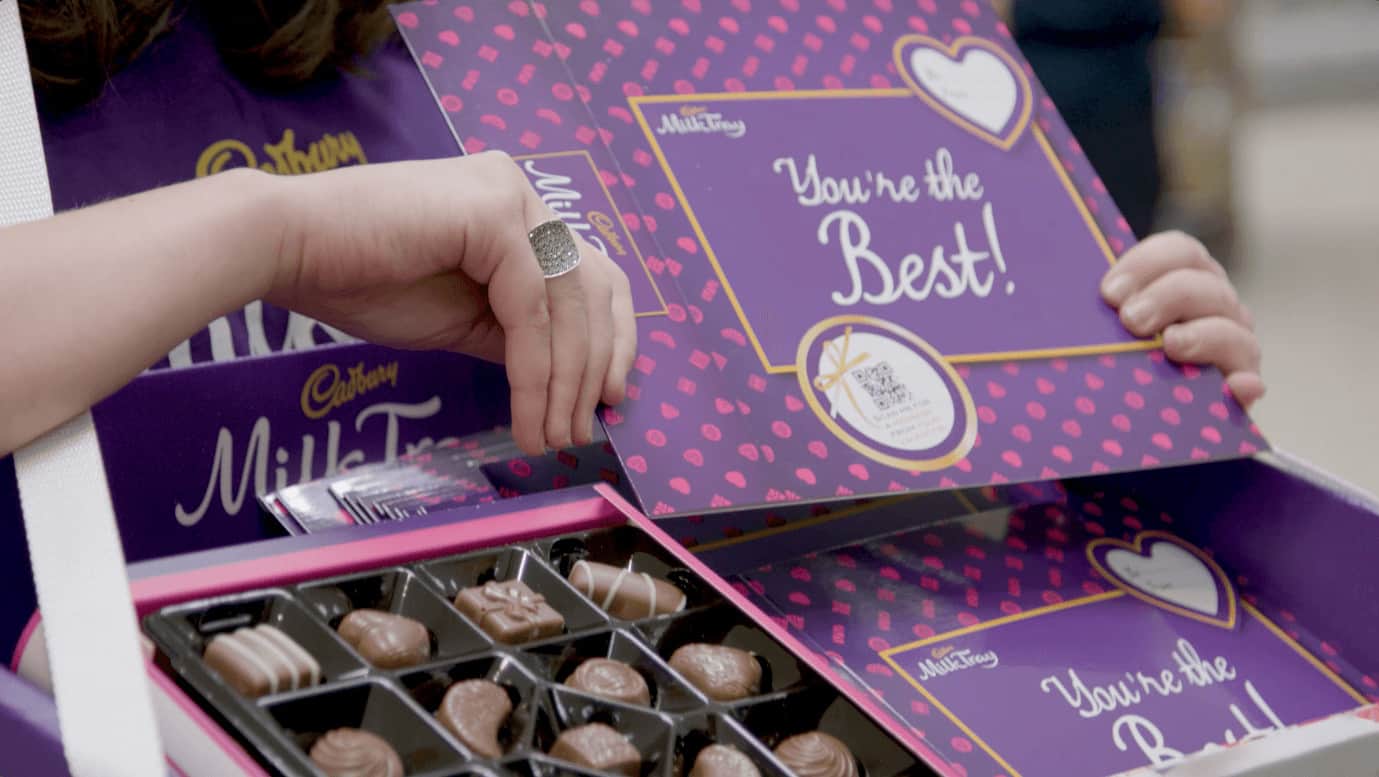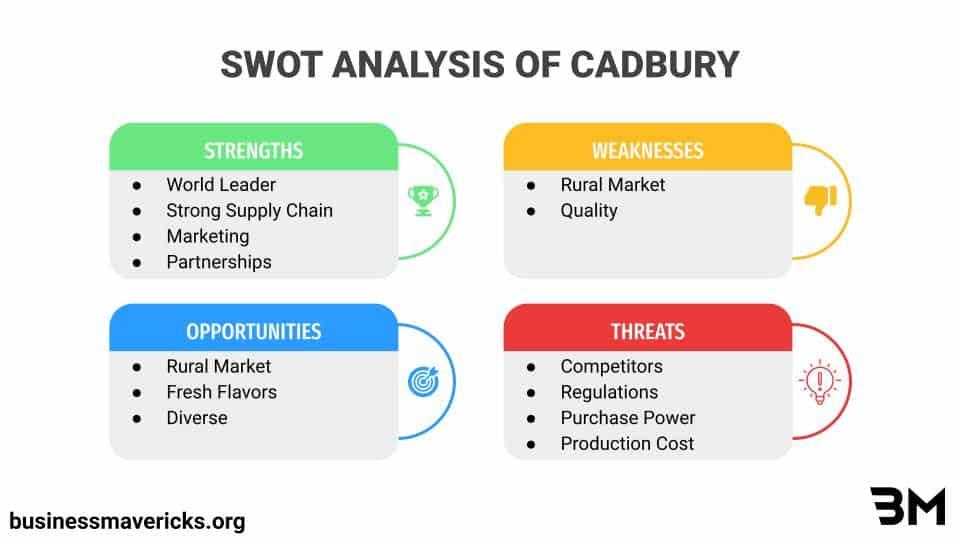Cadbury, formerly Cadbury’s and Cadbury Schweppes, is a British multinational confectionery company fully owned by Mondelez International since 2010. It is the second-largest confectionery brand in the world after Mars.

Let us look into the Overview of Cadbury and then we can move on to the SWOT Analysis of Cadbury.
Content Outline
Overview of Cadbury
Cadbury has its international headquarters in Uxbridge, west London, and operates in more than 50 countries worldwide. The company is known for its milk chocolate, Cream Egg and Roses Selection Box and many other confectionery products. Cadbury is one of the best-known British brands and was named one of the UK’s most successful exporters by The Daily Telegraph in 2013.
Cadbury was founded in Birmingham, England in 1824 by John Cadbury, a Quaker who sold tea, coffee and drinking chocolate. Cadbury built the company with his brother Benjamin, followed by his sons Richard and George. George developed the Bournville estate, a model village designed to provide better living conditions for the company’s workers. Introduced in 1905, Dairy Milk chocolate contained a higher percentage of milk in the recipe compared to competing products. By 1914, chocolate was the company’s best-selling product. Cadbury, along with Rowntree’s and Fry’s, were the three major British confectionery manufacturers for much of the 19th and 20th centuries.
Cadbury received its first royal warrant from Queen Victoria in 1854. Since 1955, the company has held a Royal Warrant from Elizabeth II. Cadbury merged with J. S. Fry & Sons in 1919 and with Schweppes in 1969, which was known as Cadbury Schweppes until 2008 when the American beverage business was split as Dr Pepper Snapple Group; the rights to the Schweppes brand had already been different in different countries since 2006. Cadbury was a staple of the FTSE 100 index on the London Stock Exchange from its inception in 1984 until its acquisition by Kraft Foods Inc. in 2010.
Did You Know?
The first Cadbury factory opened in 1841
SWOT Analysis of Cadbury
The SWOT Analysis of Cadbury includes its strengths, weaknesses, opportunities, and threats. And in this reading of the SWOT Analysis of Cadbury, we will examine this beauty and wellness company in terms of its internal and external factors.

S Stands For Strengths ( Internal Factor )
- World leader: Cadbury is the world leader in chocolate manufacturing. Cadbury is considered the company with the best production and a large distribution platform and is present in 160 or more countries.
- Strong brands and products: Cadbury has several strong brands like Dairy Milk, Bournvita, Oreo, Five Star and others in its product range. The products are of high quality and some of them are the cash cows of Cadbury.
The products of Cadbury are having great brand loyalty, brand name, brand equity and brand loyalty. Cadbury has created a good brand image among the customers through its marketing and good branding. Cadbury’s products are highly-priced due to their quality. Cadbury has several brand names which are well known all over the world and the demand for Cadbury chocolates is very high.
- Positioning as a gift: Cadbury’s has a good selection of chocolate boxes and packaging for gifting. Some of the chocolates for gifting are Cadbury Dark Milk, Cadbury Celebrations and Cadbury Rich Dry Fruits which have been positioned as gifts over the years. The new Bournville, in particular, focuses entirely on the gifting role. This clever approach has certainly set Cadbury apart from its competitors.
- Promotions: Cadbury has one of the best promotions in the FMCG sector with the impressive tagline ” Kuch Meetha ho Jaye ” and fantastic events.
This also gives power to Cadbury because it provides excellent brand recall.
Cadbury is one of the few brands that have such a strong connection with Indian customers. Home, friends and love are important aspects of life for Indians. And to connect with the Indian audience, Cadbury has always focused on emotional marketing.
- Supply Chain Management: Cadbury has an excellent distribution strategy and like all FMCG companies, relies on the strategy of dividing the mass. It is no small feat to be supplied to 200 countries with a range of more than 40 variants. And in the last few years, Cadbury has been doing the same. Cadbury is considered the best company in India in terms of its distribution network.
Cadbury maintains a good partnership with its dealers, not only supplying them but also focusing on promoting the products and training the company.
- Entering new markets: Cadbury’s creative teams have helped the company to develop new products and enter new markets. In the past, the company has been successful in most of its initiatives in new markets.
- Product portfolio: Cadbury has a wide range of products that are offered in a variety of categories. It has a number of exclusive product offerings that the competition does not have.
- Marketing: Cadbury has a strong social media presence with millions of followers on the three most popular social networking platforms: Facebook, Twitter and Instagram. The company has a high level of customer engagement with a low response time on these channels.
and also Cadbury has a well-functioning and engaging website that attracts a large number of visitors and sales on the internet.
W Stands For Weaknesses ( Internal Factor )
- Rural Market: The limitation of Cadbury is rural distribution, assuming that there are more rural areas in India that can be covered very widely.
- Quality: Around the same time, there were a few incidents here and there, depending on the nature of the product, where cockroaches or other rodents were found in the chocolate. It is inexcusable that a brand like Cadbury should display such arrogance because quality management should not be abandoned at all when it comes to such tainted chocolates.
Also, Read Amul’s SWOT Analysis One of the competitors of Cadbury in the Indian Market.
O Stands For Opportunities ( External Factor )
- Rural markets: penetration of rural markets and distribution in rural markets can be a great opportunity for Cadbury. Cadbury has a presence abroad and needs a rural presence which will increase the presence and sales of its brands and also reach and penetrate the untapped markets.
- Fresh flavours: Indian customers have a sweet tooth and like to eat small chocolates and chocolate bars. Also, there are different flavours that customers prefer. Therefore, new flavours and new tastes are an opportunity that Cadbury will provide on a regular basis.
- Acquisitions & Diverse: Acquiring competitors may strengthen Cadbury’s market dominance, Diversification of product range into related food segments.
T Stands For Threats ( External Factor )
- Costs and Price Rise: Distribution prices have risen with the increase in fuel prices and shipping costs. At the same time, procurement and production costs are also high. The continued increase in cost and hence price of the product is also a challenge for Cadbury over the years as it creates a vacuum for other companies to enter.
- Health awareness is on the rise: Health consciousness is on the rise in the Indian population. Instead of eating chocolates, many people like to reach for healthy juices and fruits. Every week you read articles in newspapers and blogs warning against eating chocolate and touting the benefits of a healthy lifestyle. Around the same time, many parents have avoided offering chocolate to their children because they fear the negative effects.
- The decline in Gifting Culture: For years Cadbury has held the role of a gift at festivals and holidays, diminishing their importance. What happens when these festivals lose importance? Chocolate sales also decline.
- Increase In Purchase Power: Increasing demand for individuals, increasing purchasing power. If you give kids a cookie today, they probably need a toy car, a bike, or a young adult gadget. So as purchasing power has risen, so have the demands on gifts, and chocolate alone is no longer enough. This is also a threat to Cadbury.
- Regulations: Changes in government regulations and policies can directly affect the company.
- Competition Competitor pricing and similar competing products pose a great challenge to the company.
SWOT Analysis Of Cadbury Key Takeaways
The SWOT Analysis of Cadbury highlights where the brand currently stands and its threats in this era. Following the detailed SWOT Analysis of Cadbury Here are a Few Important Key Points.
- Strong Brand Image
- Gift Cultures
- Competition from local players
Suggestions:
Following the detailed SWOT Analysis of Tata Motors, we have a few suggestions from Business Mavericks:
- Purchasing power
- The raw material costs rise
Cadbury STP & USP
- Segment: People who buy chocolates for eating or gifting.
- Target Group: Children and families belonging to lower, middle and upper-middle classes.
- Positioning: Cadbury is sweet for happy occasions or auspicious beginnings.
Cadbury USP
Cadbury is one of the biggest and most trusted chocolate brands worldwide
Cadbury Products
1. Cadburys Oreo
2. Cadburys Dairy Milk
3. Cadburys Bournvita
4. Cadburys Perk
5. Cadburys 5 Star
6. Cadburys Gems
Cadbury Competitors
- Mars, Incorporated is an American multinational manufacturer of confectionery, pet food and other food products, and a provider of pet grooming services, with annual revenues of $33 billion in 2015. The company was ranked by Forbes as the 6th largest privately held company in the United States. Headquartered in McLean, Virginia, United States, the company is wholly owned by the Mars family.
- The Hershey Company, commonly known as Hershey’s, is an American multinational corporation and one of the largest chocolate manufacturers in the world. It also makes baked goods such as cookies and cakes and sells beverages such as milkshakes and more, which are produced worldwide. The company is headquartered in Hershey, Pennsylvania, which is also home to Hersheypark and Hershey’s Chocolate World.
- Nestlé S.A. is a Swiss multinational food and beverage company headquartered in Vevey, Vaud, Switzerland. It is the largest food company in the world by sales and other metrics as of 2014. It ranked 64th in the 2017 Fortune Global 500 list and 33rd in the 2016 Forbes Global 2000 list of largest publicly traded companies.
- Ferrero Rocher is a chocolate and hazelnut product manufactured by the Italian confectionery company Ferrero. Its invention is attributed to Michele Ferrero, the former owner of Ferrero SpA, who introduced the candy in 1979.
Each Ferrero Rocher ball is wrapped in foil and placed in a paper wrapper. The candy is made by machine and much of the production process is designed to be kept secret. The candy is sold worldwide and has a strong cultural presence, due in part to its association with Christmas and the popular 1990s commercial that aired in the UK.